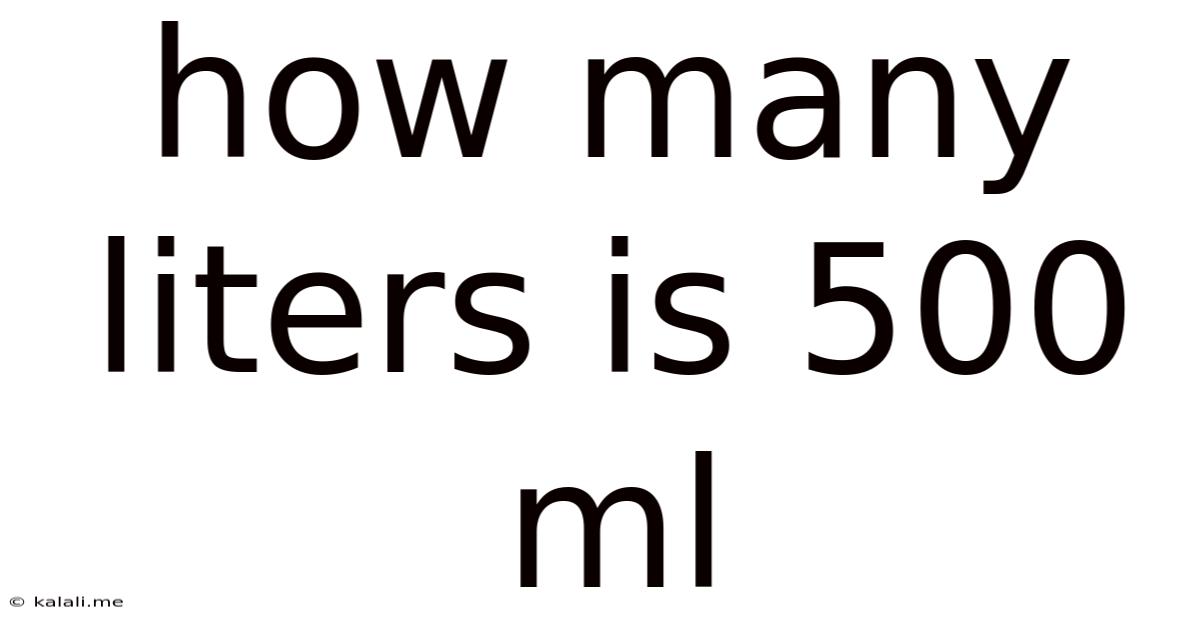How Many Liters Is 500 Ml
Kalali
Mar 06, 2025 · 4 min read

Table of Contents
How Many Liters is 500 ml? A Comprehensive Guide to Metric Conversions
Understanding metric conversions can be crucial in various aspects of life, from cooking and baking to scientific experiments and everyday measurements. One common conversion that often causes confusion is the relationship between milliliters (ml) and liters (l). This comprehensive guide will delve deep into the conversion of 500 ml to liters, explaining the process, providing practical examples, and exploring the broader context of metric conversions.
Understanding the Metric System
The metric system, also known as the International System of Units (SI), is a decimal system based on multiples of 10. This makes conversions relatively straightforward. The base unit for volume in the metric system is the liter (l). Other units, like milliliters (ml), are derived from the liter using powers of 10.
The Key Relationship: Milliliters and Liters
The fundamental relationship to remember is: 1 liter (l) = 1000 milliliters (ml). This means that a liter is 1000 times larger than a milliliter.
Converting 500 ml to Liters
Now, let's tackle the core question: How many liters is 500 ml?
Using the conversion factor above, we can easily calculate this:
500 ml * (1 l / 1000 ml) = 0.5 l
Therefore, 500 ml is equal to 0.5 liters.
Practical Applications: Real-World Examples
Understanding this conversion is important in many everyday situations. Here are some examples:
-
Cooking and Baking: Recipes often list ingredients in milliliters, especially liquids. Knowing how to convert to liters can be useful when you only have a liter measuring jug. For instance, if a recipe calls for 500 ml of milk, you would know to pour half a liter.
-
Medicine: Many liquid medications are measured in milliliters. Understanding the conversion to liters helps in comprehending dosages and ensuring accurate measurements. A 500 ml bottle of cough syrup is equivalent to 0.5 liters.
-
Science Experiments: In scientific settings, precise measurements are crucial. Converting between milliliters and liters ensures accuracy in experiments involving liquids.
-
Fuel Consumption: Fuel efficiency in vehicles is often expressed in liters per kilometer or miles per gallon. While not directly using milliliters, the underlying principle of volume measurement remains the same. Understanding the relationship between ml and liters provides a strong foundation for understanding these broader concepts.
-
Everyday Measurements: From measuring the volume of water in a bottle to calculating the capacity of a container, understanding milliliters and liters is essential for daily life tasks. Knowing that 500 ml is half a liter simplifies these calculations.
Beyond 500 ml: Mastering Metric Conversions
The conversion of 500 ml to liters provides a solid foundation for understanding other metric volume conversions. Let’s explore some related conversions:
-
Converting liters to milliliters: To convert liters to milliliters, simply multiply the number of liters by 1000. For example, 2 liters is equal to 2000 ml (2 l * 1000 ml/l = 2000 ml).
-
Other metric prefixes: The metric system uses prefixes to represent multiples of 10. Common prefixes include:
- Kilo (k): 1000 (1 kiloliter (kl) = 1000 liters)
- Centi (c): 0.01 (1 centiliter (cl) = 0.01 liters)
- Deci (d): 0.1 (1 deciliter (dl) = 0.1 liters)
Understanding these prefixes allows for seamless conversions between various units of volume.
Tips and Tricks for Accurate Conversions
-
Use conversion factors: Always use the correct conversion factor (1 l = 1000 ml) to avoid errors.
-
Double-check your calculations: It's always a good practice to verify your calculations to ensure accuracy.
-
Use online converters: Many online converters are readily available to help you with conversions. However, understanding the underlying principles is crucial for long-term mastery.
-
Practice regularly: The more you practice, the more comfortable you will become with metric conversions.
Addressing Common Misconceptions
A common misconception is that converting between units of volume is complicated. The beauty of the metric system lies in its simplicity. Once you understand the basic relationships between units, such as the relationship between milliliters and liters, conversions become straightforward.
Conclusion: Mastering Metric Conversions for Success
Understanding how many liters are in 500 ml (0.5 liters) is just one piece of the puzzle. This knowledge empowers you to confidently handle various measurement tasks. By mastering the fundamental principles of metric conversions, you enhance your problem-solving skills in various fields, from cooking to science. Practice regularly, and you'll quickly become proficient in converting between milliliters and liters and other metric units of volume. This skill will undoubtedly prove beneficial in numerous aspects of your life and professional endeavors. The ability to seamlessly convert between units not only demonstrates understanding but also enhances efficiency and precision in your work. So, embrace the simplicity of the metric system, and make conversions a breeze!
Latest Posts
Latest Posts
-
How Long Does It Take To Walk 16 Miles
Jul 17, 2025
-
How Do You Say I Know Spanish In Spanish
Jul 17, 2025
-
How Long For Eyebrow Piercing To Heal
Jul 17, 2025
-
Does A Rhombus Have 4 Right Angles
Jul 17, 2025
-
How Old Are People Born In 2003
Jul 17, 2025
Related Post
Thank you for visiting our website which covers about How Many Liters Is 500 Ml . We hope the information provided has been useful to you. Feel free to contact us if you have any questions or need further assistance. See you next time and don't miss to bookmark.